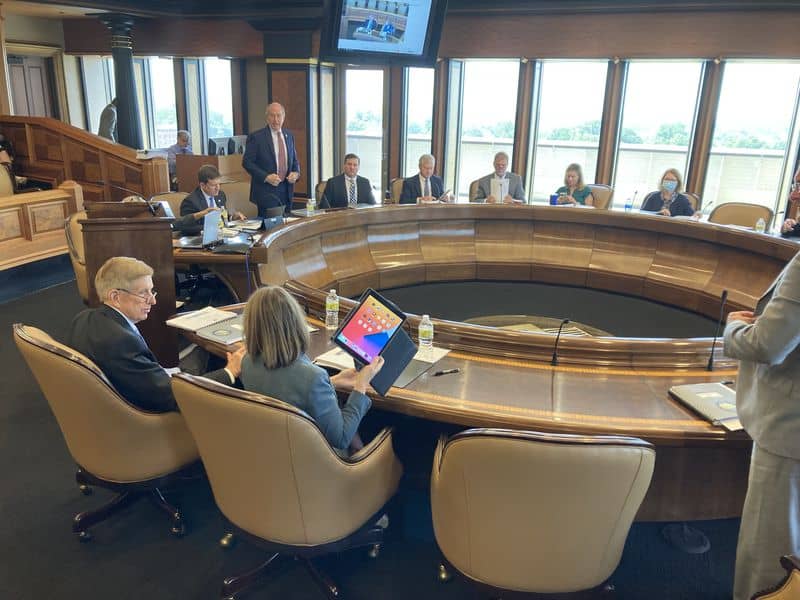Investments that are a key source of funding for Alabama’s Employees Retirement System have lost ground in the slumping financial markets this year, but officials say the pension fund is sound.
The ERS Board of Control heard a presentation on the latest numbers at its quarterly meeting in Montgomery on Tuesday morning.
Retirement Systems of Alabama CEO David Bronner also talked more broadly about the global economy and said he could not remember when it faced such a multitude of challenges.
The ERS, with $15 billion in assets, served more than 139,000 members last year, including about 52,000 active and retired state employees and members from local government entities. Through April, the rate of return on ERS investments was minus 5 percent for this fiscal year, which started Oct. 1.
Bronner, who has led the state pension program since 1973, said participants should not be concerned because they have a defined benefit plan, which means it is not dependent on the investment earnings. Plus, the long range performance of the fund has been strong, Bronner noted, including a 22 percent return last fiscal year. The 9 percent rate of return over the last 10 years puts the ERS in the top one-third of comparable public pension plans, according to the financial firm State Street.
Domestic stocks for the ERS are down about 4 percent for the fiscal year, while overall stocks are down 5 percent. Domestic stocks are the biggest portion of the ERS investments. Fixed income investments, or bonds, are down by 10 percent.
“Normally history will show you that if the stock market sells off a little bit, the bond market acts pretty good,” said Bronner, who has run the RSA since 1973. “In this situation they’re both getting killed. I mean you’re getting hurt bad. How long does it last? Will it change? Well, of course it will change. But when? That’s the question. The stock market and bond markets are being affected by the craziest confluence of different things that I’ve ever seen.”
Among those factors are soaring fuel costs and the war in Ukraine and its crippling affect on grain supplies that are a vital food source for countries in Europe and Africa, Bronner said. Drought in Africa compounds the food shortage, he said.
Bronner has led the RSA during previous economic downturns, like a stock market crash in 1987, the financial fallout after the 9/11 terrorist attacks, and the Great Recession of 2007 to 2009. The current situation is different, he said.
“It’s unusual from the point of view of having a fuel crisis, thrown on top of a food crisis, thrown on top of inflation,” Bronner said. “It’s all working against us right now. It could turn around just as fast. And when we say fast, we don’t mean tomorrow, or the next day, or the next week. But certainly in a matter of months.
“It’s just got to settle down. If we could settle the war, that would help immensely. It would help the food crisis, and probably it would also help with the gasoline prices and things like that.”
State Treasurer Young Boozer, who serves on the ERS Board, said the global problems are substantial but expressed confidence in the health of the state’s pension funds.
“The markets are in turmoil and they have been for several months,” Boozer said. “And Dr. Bronner talked about the causes of those. And they are here, they are active, and we’re going to be dealing with these things for months to come.
“How is that going to impact the fund and RSA and the participants in the plan? The plan is in good shape. We are well funded. We are well positioned. And if you look at our portfolios, we’ve got a great asset allocation. And I expect that this is just a period of turmoil that we will pass through and settle down. And I think we’re going to be in good shape going forward.”
The ERS asset allocation, as of the end of April:
- Domestic stocks: 52 percent.
- International stocks: 14.4 percent.
- Fixed income investments: 10.7 percent.
- Private placement and private equity: 7.5 percent.
- Real estate: 9.8 percent.
- Cash: 5.7 percent.
The RSA also manages the Teachers Retirement System, a larger fund with $30 billion in assets. The quarterly numbers for the TRS were released at a board meeting last week. They also showed a 5 percent loss on investments.
But last fiscal year, TRS investments earned a 22.6 percent annualized return
Overall, the RSA manages 24 funds that had total assets of about $52 billion as of the end of last fiscal year.
Bronner said the RSA’s investments other than stocks and bonds are generally doing well. Those include the Robert Trent Jones Golf Trail, nine hotel resorts across the state, and 55 Water, the largest office building in New York City.
“We’re making the most money we’ve ever made on the hotels today,” Bronner said. “Same way with the Robert Trent Jones Trail. We had the best year we’ve ever had last year (on the RTJ) and this year so far is better than last year.”

